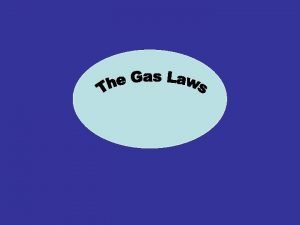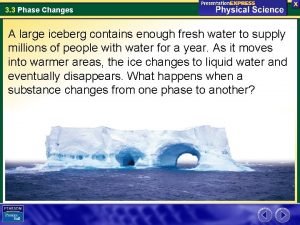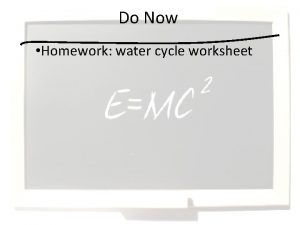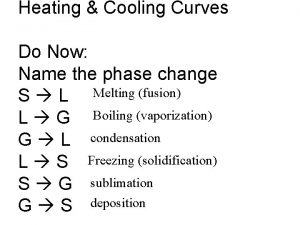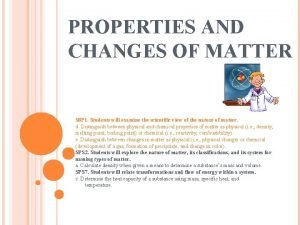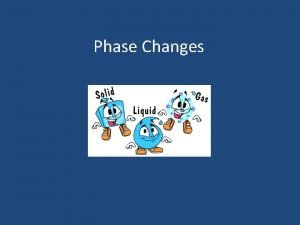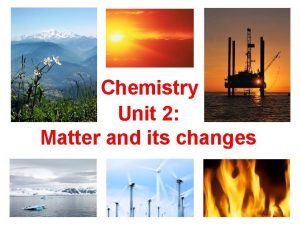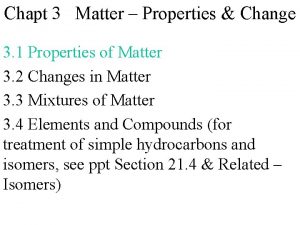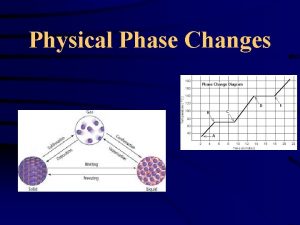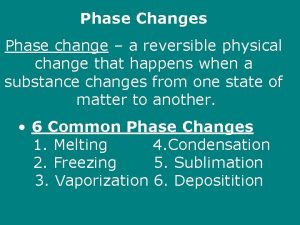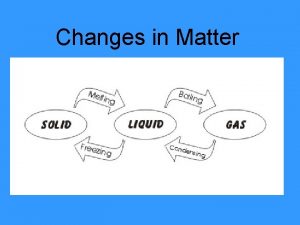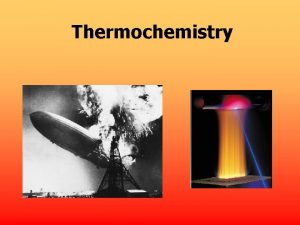PHASE CHANGES Matter can change from one state




















- Slides: 20

PHASE CHANGES • Matter can change from one state to another. This is known as a Phase Change. • All Phase Changes are Physical Changes… The Identity of the substance does not change. • Energy must be added or removed.

Chapter 3

Adding energy, a solid changes to a liquid. The process of changing a solid to a liquid is called: MELTING

When energy is removed from a liquid, it changes to a solid. The process of changing from a liquid to a solid is called…. FREEZING

Freezing can occur at any temperature… high or low!

Adding energy changes a liquid to a gas If this phase change occurs below the boiling point, it is called…. EVAPORATION

Chapter 3 Changes of State

Sweat is your body’s natural air conditioner! In order for sweat to evaporate, it needs to absorb heat from your body. This cools your skin!

If boiling occurs to change the liquid to a gas… This is known as VAPORIZING

Changing from a gas to a liquid… CONDENSATION

Sometimes a solid will change directly to a gas. Solid to Gas …. SUBLIMATION

Dry Ice can be Dangerous!! • This injury was caused by a dry ice bomb!

A gas can change directly to a solid…. Frost is an example of this process, called… DEPOSITION

The temperature at which a substance changes phase is unique for that substance and is used to help identify it. For example: The Boiling Points (at sea level)… Oxygen: -182. 95 o C (-297. 31 o F) Bromine: 58. 8 o C ( 137. 8 o F) Gold: 2856 o C ( 5173 o F)

“Freezing Point” = “Melting Point” (What you call it depends on what you start with. ) • Liquid water’s “Freezing Point” is 0 o C. • Solid water’s “Melting Point” is 0 o C.

Evaporation: Liquid to Gas • Effects of Pressure on Boiling Point The boiling point of a liquid decreases as atmospheric pressure decreases. • Atmospheric pressure is lower at higher elevations. So, the boiling point is lower on top of mountains than it is at sea level.

Boiling Points CAN change • The normal boiling point of water is 100 o. C. • But at an elevation of 10, 000 feet water boils at only 90 o. C at this elevation.


Change of Temperature Vs. Change of State • When most substances lose or gain energy either • its temperature changes • or its state changes. • But temperature does not change until a change of state is complete.

Chapter 3
 Phase changes of matter
Phase changes of matter Condensation phase change
Condensation phase change Changes of state of matter
Changes of state of matter Changes in latitudes, changes in attitudes meaning
Changes in latitudes, changes in attitudes meaning Physical changes
Physical changes All states of matter
All states of matter Heating cooling curve
Heating cooling curve 6 phase changes
6 phase changes Phase changes worksheet answer key
Phase changes worksheet answer key Are phase changes reversible
Are phase changes reversible Is vaporization endothermic or exothermic
Is vaporization endothermic or exothermic Phase changes
Phase changes Properties and changes of matter worksheet
Properties and changes of matter worksheet What is a chemical property
What is a chemical property Phases changes of matter
Phases changes of matter Definition of substance
Definition of substance Matter-properties and changes answer key
Matter-properties and changes answer key Two types of changes in matter
Two types of changes in matter Which is a big idea for matter and change
Which is a big idea for matter and change True or false: chemical and physical changes alter matter.
True or false: chemical and physical changes alter matter. Concept map matter
Concept map matter
